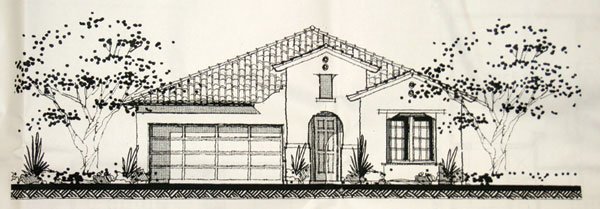North Gilroy residents who were less than thrilled with the
prospect of 72 homes being built in their backyard may have to deal
with 99.
residents reactions to the proposed housing and views of the
area proposed for development.
North Gilroy residents who were less than thrilled with the prospect of 72 homes being built in their backyard may have to deal with 99.
The old Las Animas Elementary School site at 8450 Wren Ave. is owned by the Gilroy Unified School District and zoned for a public facility. Looking to sell the land at its maximum value, the district is acting as developer, jumping through the necessary hoops to rezone the land as a medium density residential development.
The district’s applications for a zone change, tentative map and architectural and site review narrowly passed the planning commission with a four to three vote, with 80 conditions. The proposal was scheduled to go before the city council Monday night but a school board decision postponed the review.
The district has spent $300,000 so far on developing the plans, said Deputy Superintendent of Business Services Enrique Palacios. By the time the process is over, GUSD will have shelled out nearly $600,000, he estimated. However, if the district sold the land as is, it might get $7 million compared to the $13 million it could get after rezoning, he said. In today’s buyer’s market, the district is working to make the parcel as attractive as possible.
The plan originally included 113 units crammed into the 10-acre swath of land. A neighborhood outcry caused the district to significantly scale back the project. The current configuration includes 72 single-family homes. While a medium density zone allows for 16 units per acre, the district’s revised map shows only 7.2 units per acre.
But those numbers could change.
To the dismay of Wayland Lane and La Alondra Way residents who waited around for two and a half hours Thursday night to hear the board’s discussion, the 72 homes planned for the land could jump back up to 99, the maximum number of units allowed by the city.
The 72-home subdivision holds lots that vary in size from 2,240 to 10,070 square feet. The development will have two access points onto Wren Avenue. The residences lining the subdivision’s exterior are mainly single-story homes that surround two-story townhomes and a neighborhood park at the development’s center.
When the board moved on to the last item of the evening’s agenda, neighbors’ drooping eyes perked up. They left, however, discouraged by the news they heard at the meeting.
Their concerns are plentiful: traffic jams, noise, blocked views, privacy and other quality of life issues are just a few.
“These people are going to snore,” said Steve Ashford, a Wayland Lane resident of 18 years, pointing to the map that showed new homes going in only 20 feet away from lot lines, “and these people are going to hear it.”
The Ashfords and their neighbors weren’t too happy to hear that a retaining wall would be going up behind their homes, blocking out their view of the western hills. The subdivision will be at a higher elevation to prevent water from draining into existing backyards. Add an eight- or nine-foot wall, and the view will be significantly blocked out, a problem of mere aesthetics for most neighbors but a power problem for Gary Batchelder who relies on the sunlight hitting his $40,000 solar panel array to power his home. Currently, he gets sun exposure from sunrise to sunset. A retaining wall could shave off an estimated three hours of sunlight. Plus, he doesn’t want townhomes blocking his view, he said.
In order to get a better picture of what they’ll be looking at, neighbors have requested that poles and site lines be erected to show the height of the buildings.
When board members got the chance to weigh in, some expressed alarm that district staff had scaled back the project to pacify neighbors and that one of the 80 conditions included the installation of a traffic signal at the corner of Wren and Welburn avenues that could cost up to $650,000. District staff hope to delay or avoid paying for the light, citing a traffic study that shows a negligible impact between the proposed development and the school traffic at its lowest enrollment.
“Ideally, we’d like not to have to pay for it at all,” said Superintendent Deborah Flores.
“The reason the traffic signal is such an issue is because we have a $35-million gap in facilities funding,” she explained.
“We got 113 (units) down to 72 and then we kick in an extra half million?” said Trustee Denise Apuzzo. “This is what it’s like to be a developer in Gilroy … We’d be crazy to use that land for just 72 units. We need to maximize what we can get for that land. It can be one house or 100 houses – there’s going to be complaints from the neighbors. Everybody has that not-in-my-backyard syndrome.”
“If we’re entitled to 99 units, we should go back and request the 99 units,” Trustee Javier Aguirre said.
Trustees were bothered that they were being treated by the city as “just another developer.”
“The big difference between us and any other developer is that the money is going to stay here in this community,” said Trustee Francisco Dominguez. “The city should not look at us as a developer making money to go back into our pockets.”
Council members Peter Arellano and Perry Woodward listened closely to the board’s discussion and chatted with neighbors after the meeting.
Woodward agreed that the profit aims of the district were “far more noble” than those of a for-profit developer. He preferred not to take an official stand before the item came to the city council but said that his foremost concern was with the current residents, rather than the “controversial” and “long-overdue” stoplight.
“It’s a public safety issue,” he said of the busy intersection. “But I tend to agree with them that the impact (on traffic) of 72 homes is nothing like the impact of having that school out there.”
“(The school district) has made an effort to reach out to the community,” he said. “I don’t think that effort is complete.”
He said it’ll be a tough decision when it comes to the city council.
“Did the school district do their part to reach out?” said Mayor Al Pinheiro. “The community doesn’t think so.”
“The hot potato is who’s going to do what,” he said, citing the example of the traffic light. “We want to do everything we can to work with the school district, but we need to be mindful that we’re elected to protect the city of Gilroy.”
The planning commission made several concessions on the condition that the district would return the favor, said Planning Commissioner Ben Anderson, who voted against the district’s proposal. For example, the city’s zoning ordinance calls for a 2,700 square-foot lot for each two-bedroom unit. The map shows three-bedroom townhome situated on only 2,240 square feet of land.
“They’re all jammed in there like little sardines,” he said. Meanwhile, the district did not own up to their end of the bargain, he said. The design has little room for parking, narrow streets and no community-based amenities, he said.
“It looks good on paper,” said Linda Ashford of the attractive set of plans the district put together.
“But developments like this turn into slum areas real fast,” Steve Ashford said.
By the numbers
Land Value:
-As is-$5 million – $7 million
-After rezoning – $10 million – $13 million
Units:
-Under current plan – 72
-Allowed under city’s residential development ordinance – 99
Lot sizes:
-Range from 2,240 – 10,070 square feet














